
* During World War II, the Soviet aircraft design bureau run by Semyon Lavochkin developed a series of propeller fighters, notably the Lavochkin "La-5" and "La-7", that provided a significant contribution to Soviet victory. In the postwar period, Lavochkin developed a series of jet fighters, most notably the "La-15" -- but of all the different Lavochkin jet fighter designs, it was the only one that was built in any quantity, and it was quickly retired from service. This document provides a history and description of Lavochkin's jet fighters.
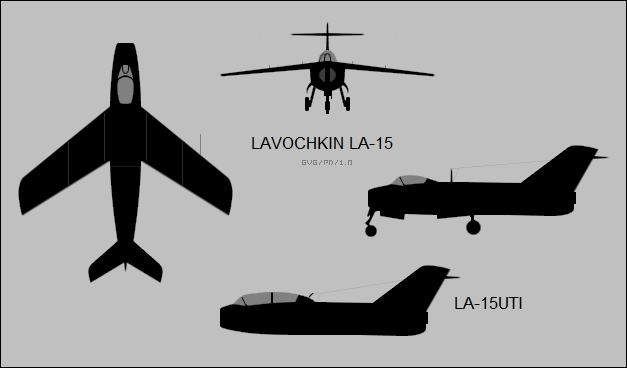
* In the last year of World War II, Germany began to introduce jet combat aircraft into service. While the US and Britain were also beginning to introduce jets, the Soviet Union was lagging well behind; although a number of Soviet engine designers, most notably Arkhip M. Lyulka, were working on turbojet engines, with experimental design bureaus (OKB in the Russian acronym) dedicated to aircraft development coming up with concepts for flying machines to be powered by them, by early 1945 it was apparent that Soviet turbojet engines weren't going to be available in the near term.
As a result, Soviet dictator Josef Stalin ordered the development of a single-seat jet fighter, based on the German Jumo 004B axial-flow turbojet, used on the Messerschmitt Me 262 twinjet fighter. The Jumo 004B was to be reverse-engineered by the Tumanskiy engine OKB as the "RD-10", where "RD" stood for "reaktivniy dvigatel" or "reaction device (jet engine)".
Aircraft prototypes were ordered from the Mikoyan, Yakovlev, and Lavochkin OKBs. The Lavochkin offering had the company code of "Izdeliye (Article) 150 (I-150)", sometimes rendered as "La-150", the aircraft being based on the "pod and boom" layout -- with a fuselage built around the Jumo turbojet, positioned behind the cockpit, and the tail assembly on the end of a boom extending from the upper fuselage. The machine's general configuration had been defined by the Central Aerodynamics & Hydrodynamics Institute (TsAGI in its Russian acronym). The first of eight prototype / pre-series I-150 machines performed its initial flight on 11 September 1946.
The I-150 was of all-metal construction; fabrication of the aircraft had been delayed, because the factory where they were build had been turning out aircraft made largely with wood, and so had little tooling for dealing with metal. The aircraft had straight wings and tailplane, plus a triangular tailfin. The wings were shoulder-mounted, while the tailplane was mid-mounted on the tailfin. It had tricycle landing gear, all gear assemblies with single wheels, the nose gear retracting backward, the main gear tucking up into the fuselage -- an unusual feature for a Soviet fighter of the era, which typically had gear that retracted into the wings -- with a resulting narrow landing gear track. The landing gear was hydraulically actuated.
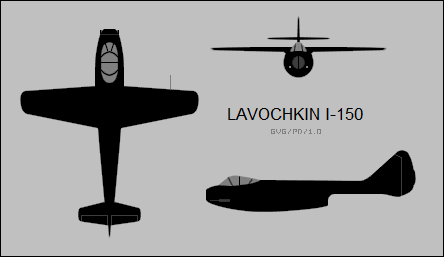
The engine intake was in the nose. The RD-10 engine provided a meager 8.8 kN (900 kgp / 2,000 lbf) thrust. The I-150 was armed with twin Nudelman-Suranov NS-23 23-millimeter cannon, mounted below the nose, with 75 rounds per gun. The cockpit was mounted well forward, with the center section of the three-piece canopy hinging open to the right; there was no ejection seat. The windscreen was of armor glass, while the cockpit also had armor protection.
___________________________________________________________________
LAVOCHKIN I-150:
___________________________________________________________________
wingspan:
8.2 meters (26 feet 11 inches)
wing area:
12.15 sq_meters (130.6 sq_feet)
length:
9.42 meters (30 feet 11 inches)
height:
2.6 meters (8 feet 6 inches)
empty weight:
2,155 kilograms (4,755 pounds)
loaded weight:
2,975 kilograms (6,555 pounds)
max speed at altitude:
880 KPH (545 MPH / 475 KT)
service ceiling:
12,600 meters (41,340 feet)
range:
495 kilometers (305 MI / 265 NMI)
___________________________________________________________________
Preliminary trials proved the I-150 a disappointment, the primary reason being the inadequate thrust of the RD-10 engine, the limited thrust also leading to unfortunate design compromises: the cockpit was small and cramped, the fuel supply too limited, and the twin cannon were seen as inadequate armament. The I-150 also suffered from lateral instability.
* Following the end of manufacturer's trials in the spring of 1947, one of the I-150s was sent back to the factory to be upgraded as the "I-150M". It had a wider and more comfortable cockpit, with an ejection seat, plus armor protection for the pilot fore and aft. The wings were also made detachable to simplify transport, and had downturned wingtips to improve lateral stability. Of course, the changes meant added weight, to the tune of several hundred kilograms, and performance deteriorated substantially, top speed being reduced to about 800 KPH (500 MPH).
Along a parallel track, the Lavochkin OKB had been working to improve the RD-10 by adding an afterburner, resulting in a turbojet, the "Izdeliye YuF (I-YuF)", that provided 30% more power, with only a modest increase in weight and length. One was fitted into an I-150 in July 1947, the aircraft being redesignated "I-150F". It had much improved performance, with a top speed of 915 KPH (570 MPH) at altitude. Although it might have seemed tempting to mate the afterburning RD-10 to the I-150M, the general perception was that would be the end of the line for the I-150, the design having no growth potential after that -- in particular, it couldn't accommodate a bigger engine. The I-150 was abandoned.
BACK_TO_TOP* The reason the Lavochkin OKB had no great problem with dumping the I-150 was because a more promising option was available. From late 1945, the bureau worked on the design of another jet fighter, the "Izdeliye 152", also to be powered by the RD-10 turbojet. The I-152 was to be easier to fly and service, and also be amenable to larger engines as they came available. The single prototype performed its first flight on 5 December 1952.
The I-152 was of all-metal construction and, like the I-150, had a pod-&-boom configuration, but it was much more along the Yakovlev Yak-17, with the engine under the forward fuselage and running under the cockpit. The wings and tailplane were straight, the wings being mid-mounted. The I-152 had tricycle landing gear, all assemblies having single wheels, the nose gear retracting backward and turning flat to fit, the main gear tucking back into the fuselage.
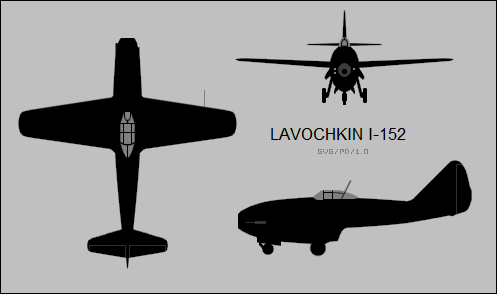
The I-152 was armed with three NS-23 23-millimeter cannon, with two cannon on the right alongside the nose, and one on the left. Ammunition supply was 50 rounds per gun. The cockpit featured front and back armor, plus an armor-glass windshield; there was no ejection seat. Length was 9.4 meters (29 feet 8 inches), wingspan was 8.2 meters (26 feet 11 inches), and empty weight was 2,310 kilograms (5,092 pounds). The prototype was, to no great surprise, underpowered, with a top speed of only about 840 KPH (455 MPH), hardly better than a good piston fighter. Worse, the RD-10 was unreliable; the prototype crashed on its eighth test flight when the engine failed, the aircraft being written off.
As noted, the I-152 was designed to permit installation of larger engines, and so work had been initiated in 1946 on the "Izdeliye 154", which was much the same as the I-152, but was to be powered by a Lyulka TR-1 turbojet with 12.3 kN (1,270 kgp / 2,800 lbf) thrust -- the first turbojet of Soviet design to actually be flight-tested, more powerful than the RD-10, if not by any great leap. Work on an I-154 prototype was begun, but it was abandoned in 1947, since the TR-1 didn't end up going into production.
* As mentioned above, the Lavochkin OKB had worked on afterburning derivatives of the RD-10 and flight-tested one of them, the I-YuF, in the I-150F. The same engine was fitted to an I-152 prototype in the fall of 1946, to be redesignated "I-152D" -- "D" for "dublyor (2nd)" -- though it was quickly changed to "I-156". The I-156 also featured enhanced cockpit armor; an ejection seat; a refined canopy; tailfin and tailplane of greater span; plus new wings with span increased to 8.52 meters (28 feet), area increased to 13.24 square meters (142.4 square feet), and a revised airfoil. Empty weight increased by about 4%.
Initial flight of the I-156 prototype was on 1 March 1947, with a second prototype following. Although performance was noticeably improved, the VVS report on conclusion of trials in early 1948 indicated the engine was unreliable, and the aircraft had handling problems. The I-156 was subsequently canceled.
* As the narrative so far suggests, the Soviets were lagging the West badly in jet engine design. A suggestion was made to Stalin that the USSR license jet designs from Britain; Stalin reportedly answered: "What fool will sell us his secrets?" However, the Atlee government in Britain still had some sympathy with their wartime ally, and the engines in question -- the Nene and Derwent centrifugal-flow turbojets -- were not secret technology. The Soviets had license-produced American aircraft during the war, including the PBY Catalina flying boat and the DC-3 airliner, so the British were not violating precedent; they sold the Soviets rights to the Nene and Derwent, which were license-built as the Klimov "RD-45" and "RD-500" respectively. They were simple, sturdy, effective engines and fit the Soviet engineering mindset perfectly.
Given engines that actually worked, the I-156 design was modified to accept an imported Derwent obtained as part of the license deal, the new variant having a very thin wing -- being accordingly assigned the designation of "Izdeliye 174TK", where "TK" stood for "tonkoye krelo (thin wing)". The pot-shaped Derwent required that the three NS-23 cannon be repositioned to under the nose. Initial flight was in early 1948; performance of the I-174TK was much better than that of its predecessors, but it had already been outpaced by improved designs, and was quickly given up in turn.
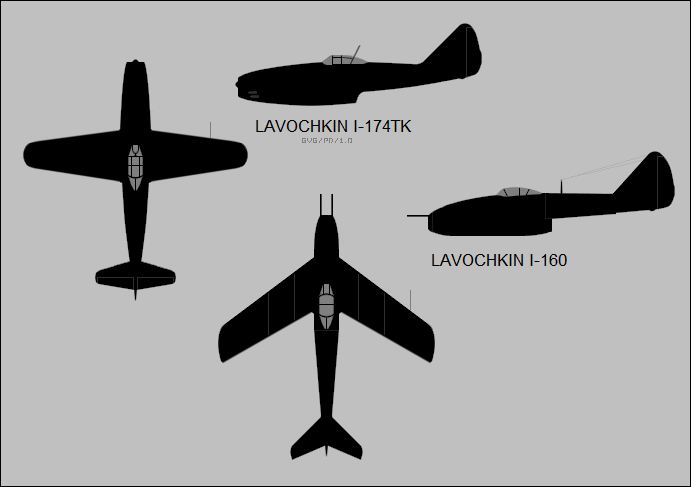
* Alongside the I-174TK, the Lavochkin OKB also developed a swept-wing derivative of the basic I-152 design, designated the "Izdeliye 160". It featured the same fuselage configuration as the other members of the family, but had a wing with a sweep of 35 degrees at quarter chord, and a similarly swept tailplane. There were twin wing fences on each wing. It was powered by an I-YuF engine, and had armament of twin N-37 37-millimeter cannon, the barrels protruding from the nose.
The I-160, which was nicknamed "Strelka", meaning "Little Arrow", was the first Soviet swept-wing fighter to take to the air. Initial flight was on 24 June 1947, with Ivan Fyodorov at the controls. Performance was impressive, but the aircraft broke up in flight from wing flutter. That was the end of the line for the I-160; it amounted to nothing more than a demonstrator for more refined swept-wing aircraft.
BACK_TO_TOP* Experience obtained from the ill-fated I-160 helped Lavochkin engineers in development of a more adequate swept-wing fighter, given the OKB designation of "Aircraft 168". It was to be powered by a Nene / RD-45 turbojet, providing 22.26 kN (2,265 kgp / 5,000 lbf) thrust.
The I-168 had a high swept wing with a sweepback of 32 degrees 20 seconds, a swept tee tail, and armament of one N-37 and two NS-23 cannon. It featured tricycle landing gear -- all with single wheels, the nose gear retracting backward, the main gear tucking forward into the fuselage. It was fitted with an airbrake on each side of the fuselage, as well as a pressurized cockpit -- a first for a Lavochkin aircraft -- with an ejection seat. It had a length of 10.56 meters (34 feet 8 inches), a wingspan of 9.5 meters (31 feet 2 inches), and an empty weight of 3,110 kilograms (6,860 pounds). Initial flight was on 22 April 1948, with Fyodorov at the controls.
A similar aircraft, the "Izdeliye 176", was also flown, this machine featuring wings with a steeper sweep of 45 degrees, with triple wing fences on each wing, and a Klimov VK-1 engine -- an improved version of the Nene / RD-45. Initial flight was on 22 September 1948, the pilot being Fyodorov once again.
On 26 December 1948, the I-176, with Oleg V. Sokolovsky at the controls, became the first Soviet aircraft to break Mach 1 -- if in a shallow dive. It was lost in a crash on 3 February 1949, Sokolovsky being killed, with the authorities instead selecting the Mikoyan MiG-15 fighter, also powered by the VK-1, for production.
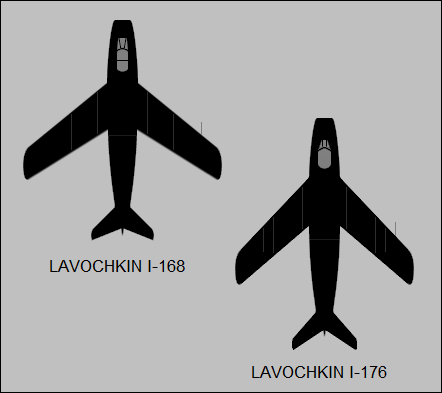
* However, working from the I-168, the Lavochkin OKB developed a new fighter scaled down to 90%, powered by the Derwent V / RD-500 turbojet -- the main driver apparently being limited availability of the more powerful RD-45 turbojet. The Lavochkin design was given the factory designation of "Izdeliye 174". Initial flight of the first prototype was on 8 January 1948, with Fyordorov at the controls; the aircraft suffered from vibration problems, resulting in its loss on 11 May 1948, Fyodorov bailing out safely. Trials continued with an improved second prototype, the "Izdeliye 174D", that cured the vibration problem, results being satisfactory enough to order it into production as the "La-15".
The La-15 was smaller than its competitor, the MiG-15, but had some general similarity. Both fighters were all-metal aircraft, with an intake in the nose, all-swept flight surfaces, and tricycle landing gear. The La-15 differed in having high-mounted instead of mid-mounted wings, with the same sweep as the wings of the I-168, and a tee tail instead of a normal tail configuration. Flight controls were conventional: one-piece flaps, ailerons, rudder, elevators; there were two fences on each wing, and a fixed ventral fin under the tail. There was an airbrake on each side of the rear fuselage, the airbrakes being hinged on the rear. All landing gear had single wheels, the nose gear retracting backward, the main gear tucking forward into the fuselage.
The La-15's RD-500 engine provided 15.6 kN (1,587 kgp / 3,500 lbf) thrust; there were twin bladder fuel tanks in the forward fuselage and an annular integral fuel tank in the rear fuselage, with a total fuel capacity of 1,100 liters (290 US gallons). The pilot sat on a bubble canopy on an ejection seat, cockpit instrumentation being typical for the time. Armament consisted of three NS-23 23-millimeter cannon, mounted under the nose, with two guns on the right and one on the left. Ammunition supply was 100 rounds per gun. A conformal external tank could be fitted under the centerline.
___________________________________________________________________
LAVOCHKIN LA-15:
___________________________________________________________________
wingspan:
8.83 meters (29 feet)
wing area:
16.16 sq_meters (174 sq_feet)
length:
9.56 meters (38 feet 1 inch)
empty weight:
2,575 kilograms (5,675 pounds)
loaded weight:
3,850 kilograms (8,490 pounds)
max speed at altitude:
1,005 KPH (625 MPH / 545 KT)
service ceiling:
13,500 meters (44,290 feet)
range:
1,145 kilometers (710 MI / 620 NMI)
___________________________________________________________________
Total production of the La-15 is given as 235 aircraft; NATO assigned it the amusing reporting name of "Fantail". The La-15 was slightly faster but had a lower climb rate than the MiG-15; the La-15 was also more agile than the MiG-15 -- presumably because it was a lightweight fighter, with only about 70% of the empty weight of the MiG-15 -- and handled nicely. There were also considerable manufacturing defects, leading to a number of crashes.
The defects were curable and not too surprising for early-production advanced aircraft, but the USSR couldn't afford to produce two comparable jet fighters. The MiG-15 was cheaper to build than the La-15, and the MiG-15's landing gear was more robust, a definite plus for operating off of rough airfields. There was also a push to standardize on the VK-1 engine, and give up on the RD-500.
Production of the La-15 was abandoned in August 1949, with all the machines grounded by 1953, their RD-500 engines being "recycled" for use with the KS-1 Kometa (NATO AS-1 Kennel) air-launched cruise missile. Some of the aircraft hulks were used as ground targets of a sort, in nuclear tests. There was work on a tandem-seat trainer version of the La-15, designated the "La-15UTI", sometimes given as "I-180", but it didn't go beyond two prototypes. The La-15 was not exported, and saw no combat action.
* Having developed second-generation jet fighters like the MiG-15 and La-15, the Soviet aircraft industry then began to work on third-generation fighters, capable of supersonic performance in level flight. The Lavochkin OKB focused on a design that would emerge as the "Izdeliye 190", which was to be powered by a Lyuka AL-5 axial-flow turbojet, providing 45.1 kN (4,600 kgp / 10,140 lbf) thrust.
The single prototype performed its initial flight in early 1951. It was of all-metal construction, with all-swept flight surfaces, and bicycle-type landing gear. The wings were mid-mounted and of tapered layout, with a leading-edge sweep of 55 degrees, featuring one-piece flaps and ailerons. The tailfin was strongly swept, with a triangular tailplane mounted at mid-height. The nose gear featured a single wheel, and retracted backward; the rear gear featured two wheels, being adjustable in height to raise the nose for take-offs; while there was retractable outrigger gear on each wingtip.
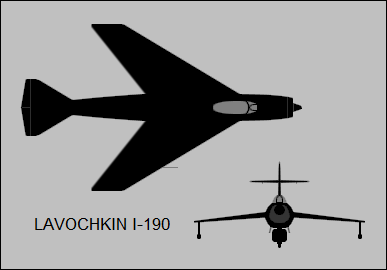
The engine intake was in the nose, with a Korshun (Kite Hawk) radar in a radome on the upper lip. Armament was to be twin N-37 37-millimeter cannon, though it is unclear that the prototype was ever fitted with radar or was armed. The pilot sat under a bubble canopy on an ejection seat. Length of the I-190 was 16.35 meters (53 feet 8 inches), wingspan was 9.9 meters (32 feet 6 inches), and empty weight was 7,315 kilograms (16,125 pounds). Initial trials showed the AL-5 engine could not meet its thrust specification, and was dangerously unreliable; the I-190 effort was abandoned after only a handful of test flights. The aircraft had been able to break Mach 1 in level flight, but work on the design was not continued, sources hinting it also had handling problems.
BACK_TO_TOP* At the outset of the Lavochkin OKB's work on jet fighters, his chief aide, Semyon Mikhailovich Alekseyev, had notions for a twinjet heavy fighter, and in fact, the work on the I-150 was paralleled by work on an "Izdeliye 160" twinjet, as a backup effort. There weren't resources at the Lavochkin OKB to do both designs; however, in 1946, Alekseyev became chief designer of his own design bureau, OKB-21 in Gorkiy, allowing him to focus on the twinjet. The "I-160" code, as noted above, was recycled and applied to the I-160 swept-wing derivative of the I-152.
The "Istrebitel 21" -- "Fighter 21", the number apparently being a reference to the OKB -- was to be a single-seat interceptor, with heavier armament than a single-engine jet fighter, and more fuel for long endurance. It would also be able to carry a drop tank or a bomb under each wing. Consideration was given to use of the RD-10 or the RD-20 turbojets, the RD-20 being a Soviet copy of the German BMW-003 turbojet -- but the decision was made to use the more powerful Lyulka TR-1 turbojet, and later derivatives of it. Work on a flight prototype and a static test item began in late 1946, with the prototype taking to the air in the fall of 1947, A.A. Popov being the project test pilot.
The "I-21-1", as the prototype was designated -- sources usually and confusingly designate it as "I-211" -- was of all-metal construction, mostly of aircraft aluminum, with some steel assemblies. It had straight flight surfaces, the wing being mid-mounted, the tailplane being mounted at the mid-height of the tailfin. There was a prominent hydraulically-operated airbrake on each side of the rear fuselage. A Lyulka TR-1A turbojet engine was mounted in a nacelle in the middle of each wing.
The aircraft had tricycle landing gear, all gear assemblies with twin wheels, the nose gear retracting backward, the main gear hinging from just inboard of the engine nacelles to retract into the inner wing. The cockpit was pressurized, featuring an ejection seat, with the jettisonable canopy hinging open to the left. The prototype was initially unarmed. The I-21-1 had a distinct resemblance to the British Gloster Meteor fighter. Although no doubt Soviet engineers were familiar with the Meteor and it may have had some influence on their thinking, the I-21-1 was very different at a detail level. It was obviously not a copy; it was simply a very obvious configuration for a jet fighter.
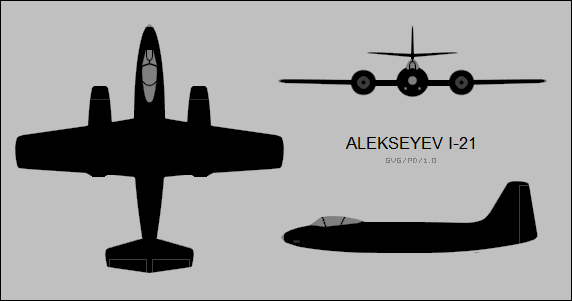
After a handful of test flights, the I-21-1 was grounded after its landing gear collapsed, due to an encounter with a pothole. It hadn't demonstrated satisfactory performance anyway so when it went back to the shop, it was refitted with Derwent V / RD-500 engines, design work having already been performed to that end. The "I-21-5", as the updated prototype was designated, was completed in late 1947, and returned to the air for trials in the spring of 1948. Unlike the I-21-1, the I-21-5 was armed, with three NS-37 37-millimeter cannon firing from under the nose.
___________________________________________________________________
ALEKSEYEV I-21-5:
___________________________________________________________________
wingspan:
12.25 meters (40 feet 2 inches)
wing area:
25 sq_meters (269.1 sq_feet)
length:
11.54 meters (37 feet 10 inches)
height:
3.68 meters (12 feet 1 inch)
empty weight:
4,010 kilograms (8,840 pounds)
loaded weight:
6,890 kilograms (15,190 pounds)
max speed at altitude:
960 KPH (595 MPH / 515 KT)
service ceiling:
13,600 meters (44,620 feet)
range:
1,700 kilometers (1,055 MI / 920 NMI)
___________________________________________________________________
Although trials went well, test pilots taking a liking to the aircraft, it was not approved for production; aircraft design was simply moving too fast at the time, the I-21 was already looking stodgy compared to newer designs coming down the pipeline. However, a second prototype, the "I-21-5D" -- again, "D" for "dublyor (2nd)" -- was built, though primarily to test a bicycle landing gear configuration, with twin wheels fore and aft, and an outrigger extending from under each engine nacelle. The rear landing gear assembly could "kneel" to raise the aircraft's nose for take-off.
The I-21-5D was put through its paces in the fall of 1949. There had been suspicion of the bicycle landing gear concept among Soviet aircraft designers, but the I-21-5D had no difficulties with take-off, landing, or ground handling. It was the end of the line. There was thought of an "I-21-6", similar to the I-21-5 but with twin 75-millimeter cannon protruding from the nose; the "I-21-7", which was an I-21 with either swept or forward-swept wings; and a heavy two-seat interceptor, the "I-22", with VK-1 / Nene engines, but none of them happened. The Alekseyev OKB was disbanded, without ever having put an aircraft into production. What happened to Alekseyev is unclear; the simplest guess is that he went back to work for Lavochkin.
BACK_TO_TOP* This document does not cover the unproduced La-200 and La-250 interceptors, those aircraft being better discussed along with Soviet production interceptors. In any case, the bottom line of Lavochkin's jet fighter efforts was that they were a dead end. With the push towards guided missiles, the Lavochkin OKB was redirected towards missile and space work -- notable efforts being the S-75 Dvina (NATO SA-2 Guideline) surface-to-air missile, plus Soviet Moon and planetary probes.
The only jet aircraft produced by the Lavochkin OKB that proved honestly successful was a drone, the Lavochkin "La-17". Work on the La-17 was initiated in 1950. Flight tests began in 1953, with prototype drones carried on a Tupolev Tu-4 four-engine bomber, which was a direct Soviet copy of the US Boeing B-29. Production of the La-17 began in 1956.
The La-17 was a jet drone of all-metal construction, with straight flight surfaces, and a jet engine carried in a nacelle under the fuselage. The initial variant, which was just known as the "La-17", was air-launched, and powered by a Bondaryuk RD-900 ramjet with 7.85 kN (800 kgp / 1,760 lbf) thrust. There was a "windmill" type electric generator in the nose of the drone to provide electric power. The La-17 was directed by radio control and simply "bellied in" to land, with the engine taking the abuse of the touchdown; the ramjet was strictly expendable and easily replaced. The drone could carry signature enhancement devices.
The original La-17 was effective, but left something to be desired. Air launch was expensive and logistically clumsy, making simulations of "mass attacks" with drones difficult at best, and the ramjet engine was thirsty, resulting in such short endurance that if a fighter pilot missed the drone on his first pass, it would have run out of fuel before he could come around again. To address these problems, Lavochkin engineers came up with a ground-launched variant with a turbojet powerplant, the "La-17M", which performed its initial flights in 1959 and went into service in 1960. The La-17M was launched using a rocket-assisted take-off (RATO) booster under each wing root, from a four-wheel towed launcher derived from the carriage for a standard 100-millimeter antiaircraft gun.
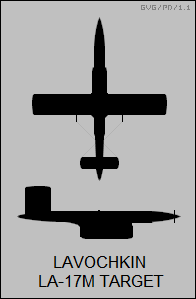
The drone was powered by a Mikulin RD-9BK turbojet with 19.1 kN (1,950 kgp / 4,300 lbf) thrust; the RD-9BK was a derated, non-afterburning, and simplified version of the RD-9B engine used on the Mikoyan MiG-19 fighter. There were teardrop fairings on the wingtips -- not for radar enhancement devices, but for compressed air that would be fed to the engine to boost the flight ceiling. Flight endurance improved from the 40 minutes of the La-17 to 60 minutes. As with the La-17, the La-17M bellied in to land.
___________________________________________________________________
LAVOCHKIN LA-17M:
___________________________________________________________________
wingspan:
7.50 meters (24 feet 7 inches)
length:
8.44 meters (27 feet 9 inches)
launch weight:
3,065 kilograms (6,758 pounds)
maximum speed:
900 KPH (560 MPH / 485 KT)
service ceiling:
17,000 meters (55,770 feet)
endurance:
60 minutes
___________________________________________________________________
Early production La-17Ms were strictly radio-controlled, and didn't have an autopilot; they were quickly replaced by the "La-17MA", which did. Later production featured the RD-9BKR engine, with the same performance as the RD-9BK but with some minor changes to permit low-level operation, and the service life improved from 15 to 30 hours. Later machines also featured an improved landing control system that caused the drone to "nose up" before touchdown, as well as a landing skid under the engine nacelle. These two refinements permitted landings with much less risk of engine damage. These machines were designated "La-17MM" and went into service in 1964. A number of old ramjet-powered La-17s were updated for ground launch, with the twin RATO boosters and some airframe reinforcements. These drones were redesignated "La-17n".
* Early on, there was some work to use the ramjet-powered La-17 as the basis for an air-launched reconnaissance drone, but because of the deficiencies of the early La-17, it didn't happen. However, a ground-launched battlefield reconnaissance drone based on the La-17MM, the "La-17R", was introduced in 1962. It featured a nose stretched by 54 centimeters (22 inches) to accommodate a reconnaissance payload. Ultimately a number of different payloads were developed, including high resolution or wide area film cameras, a real-time TV camera, and a radiation monitoring instrument. The La-17R didn't have the wingtip compressed air pods for high altitude operation fitted to the La-17M. An improved version of the La-17R, the "La-17RM", was introduced in 1965, featuring some of the refinements of the La-17MM target drone.
The evolution of the target and reconnaissance variants of the La-17 progressed along two paths, with the result that commonality between the two branches of the family diverged. In order to rationalize production and logistics, a target drone designated the "La-17UM" and a reconnaissance drone designated the "La-17RU" were built, the two machines being designed for the maximum parts commonality.
* These were the last La-17s built by the Lavochkin OKB, but not the last La-17s built in the USSR. As the Lavochkin OKB became more and more involved in the development of space systems, the production of La-17s proceeded on "autopilot" into the late 1970s -- until availability of RD-9BK engines dried up, meaning that it was no longer possible to build the La-17 as it was.
A group of aerospace organizations then came up with the "R11K", an expendable non-afterburning version of the Tumanskiy R11F-300 turbojet, used on first-generation Mikoyan MiG-21 fighters, and the La-17 was redesigned to be fitted with this engine. The Sokol OKB began production of this re-engined La-17 in the late 1970s; as far as the armed services went, it was still an La-17MM, but it had an internal OKB designation of "La-17K". The R11K engines were rebuilds of retired R11F-300 engines. The La-17K remained in production into the early 1990s. It is now generally out of service.
* It doesn't appear that the La-17 family was widely exported, though La-17RM reconnaissance drones were provided to Syria in the 1980s. The Chinese also obtained the La-17 and in fact built it themselves, though not under a license agreement. In the late 1950s, a number of La-17s had been handed over to the People's Republic of China. Stocks began running low in the later half of the 1960s, when relations with the USSR were very poor, so an effort was begun to reverse-engineer the La-17 and build it in China. The resulting product, the "Chang Kong (Blue Sky) 1" or "CK-1", was introduced to service in 1977. It was powered by the WP-6 engine, which was a Chinese copy of the RD-9B, with the drone featuring some system changes from the original La-17s used as a pattern. It also featured a parachute recovery system.
The CK-1 was quickly followed by the "CK-1A", which had underwing pods for additional kit. A "CK-1B" was introduced into service in 1983 that was optimized for low-level flight and had non-jettisonable underwing fuel tanks. It was followed by the "CK-1C", with a much improved control system to provide greater maneuverability, as well as airframe reinforcement to withstand maneuvering stresses.
BACK_TO_TOP* Sources include:
* Revision history:
v1.0.0 / 01 jan 16 v1.0.1 / 01 dec 17 / Review & polish. v1.0.2 / 01 oct 19 / Review & polish. v1.0.3 / 01 aug 21 / Review & polish. v1.0.4 / 01 jul 23 / Review & polish. v1.0.5 / 01 jul 25 / Review & polish. (*)BACK_TO_TOP
